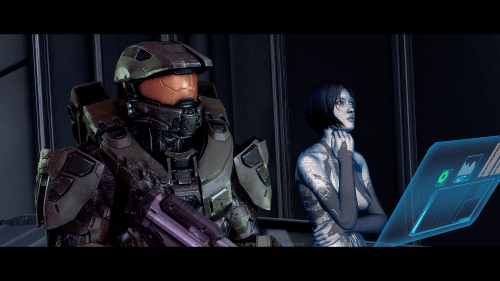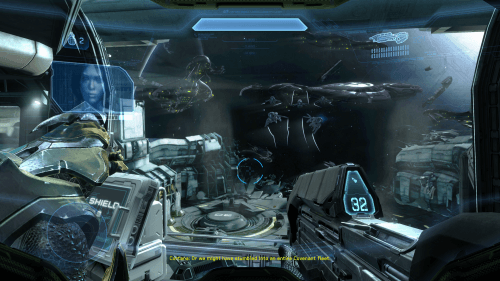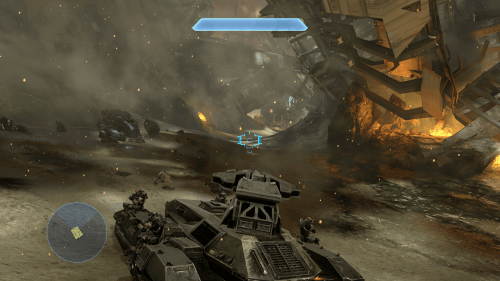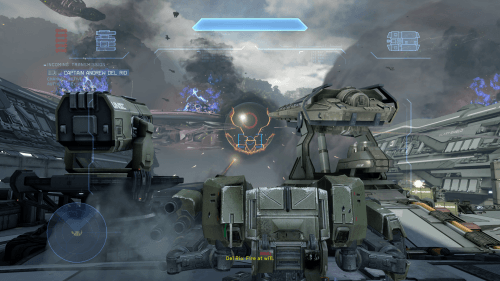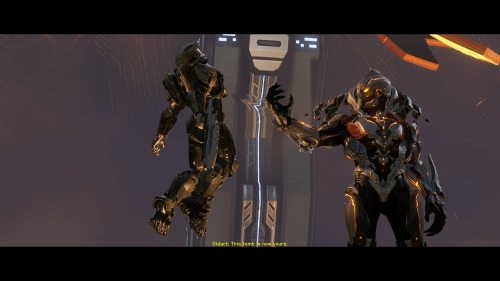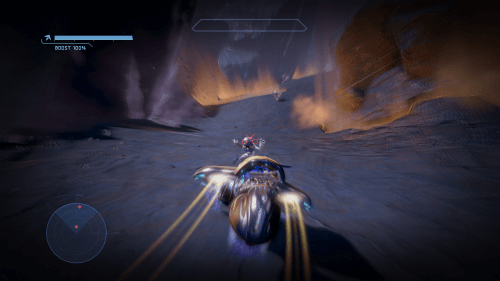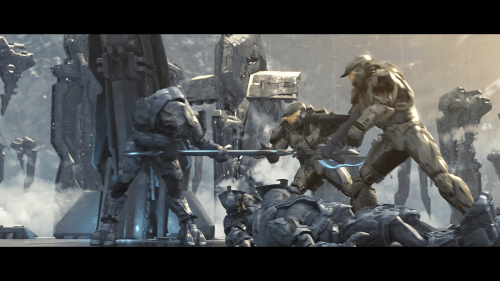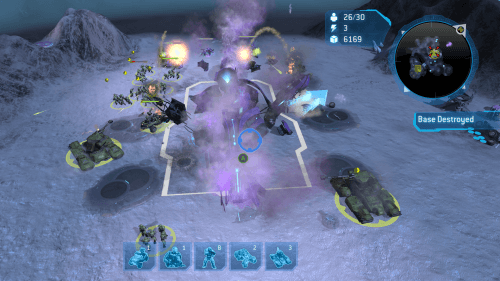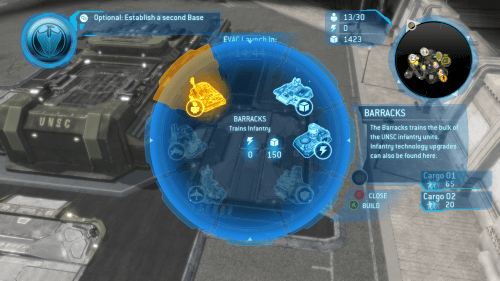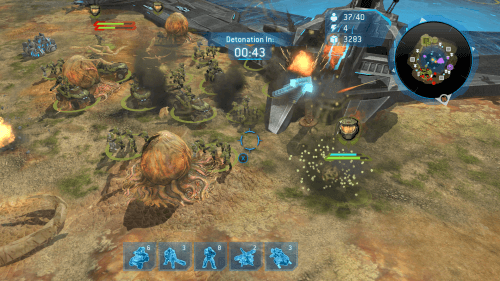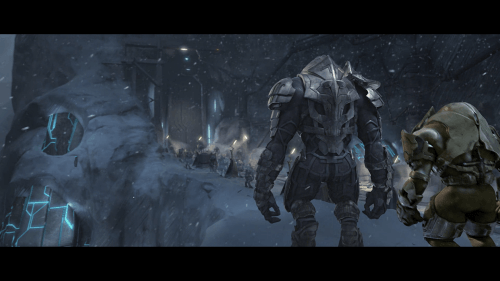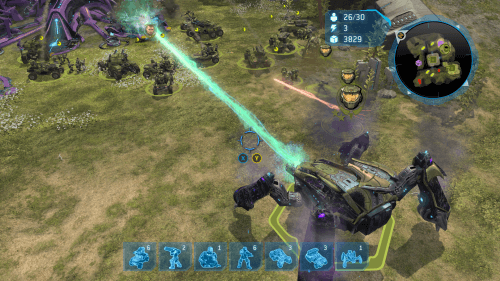The Story So Far: Adrift for over 4 years, the crippled UNSC frigate Forward Unto Dawn is pulled towards a mysterious object. Cortana wakes the Master Chief from cryosleep and the pair discover that they’re being attacked by a splinter fleet of Covenant loyalists led by the Sangeili Jul’Mdama. Without warning the object opens and violently pulls all nearby ships into it. Crashing onto the interior surface of what they learn is the Forerunner Shield World Requiem, Cortana picks up a faint signal from another UNSC ship, the supercarrier Infinity. Attempting to warn the Infinity of Requiem’s gravity well, the pair unwittingly release an ancient Forerunner warrior leader, the Didact, from stasis. The Didact resumes control of his army of defensive constructs, the Prometheans, with Jul’Mdama’s faction also falling into his ranks. Barely escaping, Master Chief and Cortana reach Infinity’s crash site where Master Chief rallies the UNSC defense, forcing the Didact into retreat. Aboard the Infinity Captain Del Rio dispatches a force to disable Requiem’s gravity generators so that the Infinity can escape. In the process the Master Chief is lured to a Forerunner facility where he’s contacted by the AI imprint of an ancient Forerunner called the Librarian. Explaining that the Didact intends to use a device called the Composer which had been used to digitally conscript living beings, including humans, into Prometheans to fight against the Flood, she insists that he must be stopped. Upon returning to the Infinity, Captain Del Rio observes Cortana’s instability and orders Master Chief to surrender her, ordering his arrest when he refuses. Instead, the Infinity’s executive officer, Commander Lasky, aids the Chief by procuring Pelican gunship for him. The Didact departs Requiem aboard his flagship, the Mantle’s Approach, though the Chief and Cortana make it just in time to stowaway on an accompanying Covenant dropship. Later hijacking the ship, the pair head to Ivanoff Station, a research facility where the Composer has been relocated. They find the station already under assault and attempt to sabotage the Composer before the Didact can reclaim it. Failing, they witness the Didact unleash the Composer on the station to devastating effect. Master Chief and Cortana then arm a Broadsword fighter with a HAVOK nuclear missile and pursue the Mantle’s Approach as it heads for Earth. Crashing into the ship’s interior, Master Chief takes the warhead and continues to fight his way to the Didact on foot. Confronting him, Cortana distracts the Didact for long enough for the Chief to manually arm the warhead. Cortana is able to teleport the Chief safely off of the ship but sacrifices herself in the process. Master Chief is later found and brought back aboard the Infinity where he quietly mourns the loss of Cortana.
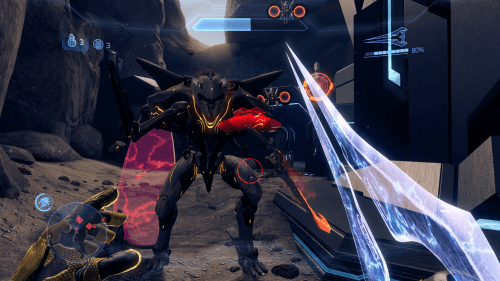
“Oh goody, more Knights…”
Replacing the popular Firefight wave survival mode first introduced with Halo 3: ODST and iterated on with Halo: Reach, Halo 4 included a separate episodic co-op oriented campaign called “Spartan Ops”. 343 Industries might have opted to do this as part of an effort to canonize Halo 4’s multiplayer (AKA “Halo: Infinity”) with competitive modes being presented as war games conducted aboard the UNSC Infinity. Similarly, and the reason I wanted to cover Spartan Ops despite not talking too much about multiplayer during my Halo Fest posts is that, unlike Firefight, the Spartan Ops campaign actually includes a full story, taking place just after the events of Halo 4.
Back in the day I had started to work my way through Spartan Ops by myself on “Heroic” difficulty but quickly discovered that it was definitely tuned for 4 person cooperative play. Between this and that it still retained much of Firefight’s wave survival gameplay (and you were fighting damned Prometheans a lot of the time to boot) it was quite the slog. I think I made it as far as episode 2 before burning out, and I believe this is a huge reason for that negative impression of Halo 4 I’d been carrying around for almost a decade now. Going back to the campaign in 2021, I decided that cranking my difficulty down to “Easy” would probably be a solid first step in meeting my goal of making it all the way through this time.
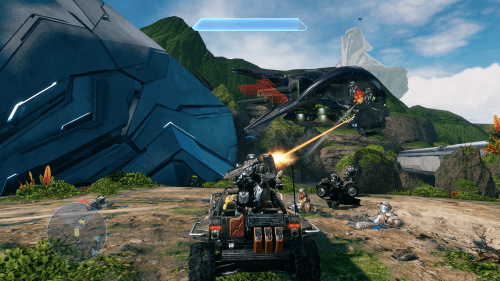
“What can I say? The Warthog never gets old!”
While still not a total cakewalk, there were a few things unique to Spartan Ops that made it a bit more tolerable. For one, weapon racks and ammo crates are generously placed throughout each map. Sure, you may still need to grab a Covenant or Promethean weapon from time to time, but you’ll have the option of using UNSC weapons without worrying about running out of ammo much more often than in Halo 4 proper. There are also special ordnance drops that are given to you during many missions, usually when there’s a particular reason you might need a special weapon; rocket launchers being dropped for you just before a pair (or multiple pairs) of Hunters show up is a common example. You also get to use your multiplayer loadouts which means access to your choice of basic weapons and grenades, equipment, and special “tactical packages” and “support upgrades”. Finally, being multiplayer oriented, you simply respawn if you die rather than having to jump back to your last checkpoint. Nice!
Gameplay wise, your fireteam is dropped into an area and issued a linear string of objectives, coming one at a time to appear more dynamic. For instance, you might be sent to a waypoint, then told to activate a McGuffin, then told to defend the area against a few waves of enemies, then told to reach the extraction point and… oh no, reinforcements! Better defeat a few more waves so you can extract! You get the point. In the first 5 episodes this gets very formulaic and very repetitive very quickly. Even more so when you consider that the same 8 maps are featured multiple times in those 25 levels, and many of them are based on sections from the main Halo 4 campaign or are straight up taken from multiplayer in the first place.
Episodes 6 through 10 greatly improve things by introducing a new batch of maps which feel purposely crafted to be used this way. They also do a better job of varying the gameplay, though the tradeoff is that some chapters end up feeling more like single player campaign missions than Firefight-like scenarios. That said, all 10 episodes have some cool moments, including some awesome vehicle-centric sections. It should also be noted that Spartan Ops doesn’t suffer from the issue of having confined, linear levels that I mentioned in my Halo 4 post. Even some of the small maps feel very open which is refreshing when coming straight from the main campaign.
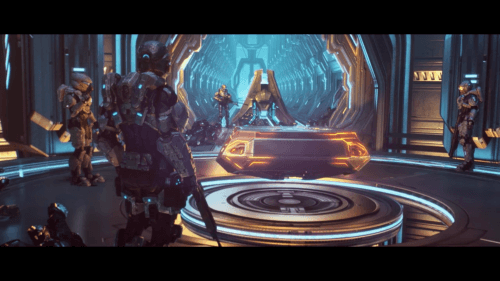
“Palmer and Majestic capture another Forerunner artifact.”
Presentation is another story. Individual chapters start and end with short in-game cutscenes and there are numerous radio communications from your mission handlers about your objectives throughout. Most notably, the biggest story beats are told via lengthy, beautiful rendered cutscenes created by Axis Animation that kick off every new episode and focus on a core cast of characters, many of whom you’ve already met in Halo 4. Honestly, say what you will about Halo 4, but these cutscenes are peak Halo awesomeness in my opinion and I’d love an entire series done this way.
The story itself is quite good too. Untangled from the legacy of Master Chief’s story and the perceived lore complexities of introducing the Didact and the Librarian, I’d suggest perhaps better than Halo 4’s. I definitely got pretty into it in any case. For one, I know he didn’t originate with Halo 4, but I thought Jul’Mdama was a great, more grounded antagonist. I also like getting some insight into the SPARTAN-IVs and the idea of Dr. Halsey feeling somewhat left behind as more advancements are made without her (which I feel is a more realistic narrative than making her cartoonish traitor.) Hell, I even started to like Sarah Palmer by the end of the campaign thanks in large part to the way her relationship with Lasky is depicted. The 10 episode story arc has a satisfying enough conclusion while also leaving some major developments wide open and begging for a sequel. I don’t know if one was actually planned or not, but sadly, a second season of Spartan Ops would never arrive, leaving the story to need to be fully resolved elsewhere.
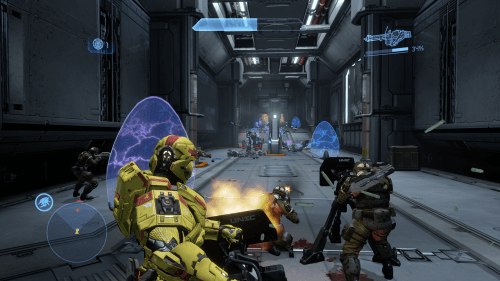
“Fun times in the corridors of the Infinity.”
All in all, Spartan Ops is a pretty damn cool batch of bonus content that I doubt a lot of Halo fans have experienced. While I’m not sure I can heartily recommend it to solo players, there were numerous chapters that stuck out to me as likely being incredibly fun when played cooperatively while I was playing through. That said, in the exceedingly likely event that you’re unable to convince even a single buddy to play through this huge 50 mission campaign with you, watching a compilation of its awesome cutscenes is still an absolutely worthy investment of your time and that, at least, gets that my recommendation.
Next up, something completely different…
